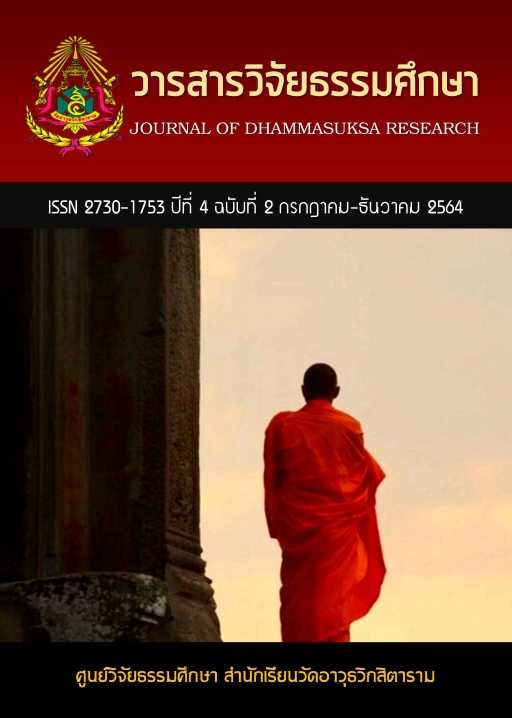การเสริมสร้างสุขภาพจิตเพื่อป้องกันการทำอัตตวินิบาตกรรมตามแนวพุทธปรัชญาเถรวาทของประชาชนในเขตกรุงเทพมหานคร
คำสำคัญ:
การสร้างสุขภาพจิต, อัตตวินิบาตกรรม, พุทธปรัชญาบทคัดย่อ
งานวิจัยเชิงคุณภาพเรื่องนี้ มีวัตถุประสงค์ คือ 1) เพื่อศึกษาแนวคิดทฤษฎีเกี่ยวกับอัตตวินิบาตกรรม 2) เพื่อศึกษาแนวคิดทฤษฎีเกี่ยวกับอัตตวินิบาตกรรมตามแนวพุทธปรัชญาเถรวาท และ 3) เพื่อวิเคราะห์การเสริมสร้างสุขภาพจิต เพื่อป้องกันการทำอัตวินิบาตกรรมตามแนวพุทธปรัชญาเถรวาทของประชาชนในเขตกรุงเทพมหานคร โดยได้เลือกผู้ทรงคุณวุฒิในการให้สัมภาษณ์ จำนวน 5 รูป/คน? เครื่องมือวิจัยที่ใช้ในการเก็บรวบรวม ได้แก่ แบบสัมภาษณ์เชิงลึกรายบุคคล โทรศัพท์มือถือ แบบบันทึก กล้องถ่ายรูป แล้วตรวจความถูกต้องสมบูรณ์ของข้อมูลและวิเคราะห์ข้อมูลเชิงเนื้อหา
ผลการวิจัย พบว่า 1) แนวคิดเกี่ยวกับการฆ่าตัวตายตามแนวพุทธปรัชญาเถรวาท ถือว่าชีวิตเป็นสิ่งที่หาได้โดยยาก และควรทะนุถนอมหรือพยายามรักษาให้ดีที่สุด การพรากชีวิตนั้นจึงถือว่าเป็นสิ่งที่ไม่ดีและจัดว่าเป็นบาปหนัก อย่างไรก็ตาม การฆ่าตัวตายนั้นยังมีบางกรณีที่พระพุทธองค์ตรัสว่าเป็นการกระทำที่ปราศจากการติเตียน หรือไม่สมควรได้รับการติเตียน ในขณะที่ฆ่าตัวตายนั้นสามารถกำจัดกิเลสได้และบรรลุอรหันต์ในที่สุด ส่วนกรณีการฆ่าตัวตายของปุถุชนทั่วไปนั้นเป็นการกระทำที่ไม่สมควรทำอย่างยิ่งและสมควรได้รับการติเตียน ส่วนการฆ่าตัวตายของนักปรัชญากลุ่มวัตถุนิยมถือว่าความตายหรือการฆ่าตัวตายเกิดจากการเปลี่ยนแปลงของมวลสารหรือเกิดจากการที่สสารแยกออกจากกัน ซึ่งถือว่าเป็นเรื่องปกติของสสาร? แต่แนวคิดของจิตนิยม มองว่าการตายหรือการฆ่าตัวตายนั้นเกิดจากการที่จิตแยกออกจากร่างกาย ฉะนั้น?? การฆ่าตัวตายจึงเป็นการแยกจิตออกจากกาย แต่อาจจะเป็นการแยกที่ผิดปกติ อันเนื่องมาจากจิตก็เป็นได้? 2) การฆ่าตัวตายนั้นพุทธปรัชญาถือว่าเป็นเรื่องที่ควรถูกตำหนิและเป็นบาปอย่างยิ่ง ซึ่งมีสาเหตุมาจากกิเลสสามประการคือ โลภะ โทสะและโมหะ กิเลสทั้ง 3 ประการนี้เป็นสาเหตุของโรคทางจิตใจ โอกาสที่ปุถุชนซึ่งยังมีกิเลสจะปลอดจากโรคทางจิตใจนั้นเป็นการยากยิ่ง? ดังนั้น มนุษย์ที่เป็นปุถุชนทั้งหมดจึงเป็นผู้ที่เป็นโรคทางจิต? แต่จะอยู่ในขั้นรุนแรงเพียงไรนั้น ขึ้นอยู่กับการควบคุมกิเลสเหล่านั้น เพราะถ้าไม่สามารถควบคุมได้ก็จะกลายเป็นผู้ที่มีสุขภาพจิตที่ต้องได้รับการบำบัดอย่างเร่งด่วน บุคคลเหล่านั้นจัดว่าเป็นผู้มีสุขภาพจิตเสีย ส่วนผู้ที่พอจะควบคุมไม่ให้แสดงออกตามแรงกิเลสได้ ก็พอจะค่อย ๆ บรรเทาต่อไปได้ ไม่ถือว่าอยู่ในขั้นรุนแรง 3) การแก้ไขปัญหาในการป้องกันการทำอัตวินิบาตกรรมตามแนวพุทธปรัชญาเถรวาท ได้เสนอไว้ดังนี้ คือ 1) การรักษาทางกาย หมายความว่า เมื่อเกิดความไม่สบายทางกายก็พยายามหาสาเหตุว่าความไม่สบายนั้นเกิดจากอะไร เมื่อทราบแล้วก็ทำการรักษาโดยวิธีที่เหมาะสม กล่าวคืออาจจะใช้ยารักษา หรือใช้สมาธิในการบำบัดรักษา นักวิชาการด้านวัตถุนิยมเชื่อว่าร่างกายไม่สบายเกิดจากที่สารเปลี่ยนรูปแบบหรือมีรูปแบบทึ่ไม่คงที่ ฉะนั้นวิธีแก้ของเขาคือ พยายามทำให้สสารเหล่านั้นคงที่อยู่ในสภาพปกติ โดยการข่มใจ ซึ่งจิตหรือใจในทรรศนะวัตถุนิยมนั้นคือ สสาร นั่นเอง 2) การรักษาทางใจ จากการวิเคราะห์สามารถสรุปได้ดังนี้ 1) ตั้งสติให้มั่นคง? พยายามทำใจยอมรับกับเหตุการณ์ที่เกิดขึ้น 2) พยายามคิดว่าสิ่งที่เกิดขึ้นเป็นเรื่องธรรมดาที่ย่อมเกิดขึ้นกับทุกสรรพสิ่ง ได้แก่ พิจารณาให้เป็นสัจธรรมคือความจริงที่ต้องมีความเป็นไปเช่นนั้น เช่น มีความทุกข์ ก็มีความสุข เป็นต้น 3)? พยายามใช้เหตุผลในการแก้ไขปัญหาต่าง ๆ ที่เกิดขึ้นโดยสืบสาวหาสาเหตุ และแก้ปัญหานั้นที่ต้นเหตุด้วยการใช้เหตุผล อย่าใช้อารมณ์ในการแก้ไขปัญหานั้น ๆ ?4) พยายามใช้ปัญญาในการพิจารณาให้เห็นความเป็นจริงของปัญหาและทางออกของปัญหานั้น โดยอยู่ภายใต้หลักการของเหตุผล? 5) ปลูกฝังให้มีการศึกษาเรียนรู้เข้าใจในหลักธรรมคำสอนทางพระพุทธศาสนา โดยเฉพาะหลักของไตรลักษณ์ ได้แก่ อนิจจตา อนัตตตา และทุกขตา เพื่อให้เกิดธรรมสังเวช
เอกสารอ้างอิง
กรมสุขภาพจิต กระทรวงสาธารณสุข. (2541). แนวทางการนำเสนอข่าวเชิงป้องกันการฆ่าตัวตาย. กรุงเทพมหานคร:วงศ์กมล โปรดักชั่น.
กรมสุขภาพจิต กระทรวงสาธารณสุข. (2543). กรอบการวิจัยสุขภาพจิต. พระนคร : อุดมศึกษา.
กองวิจัยสำนักงานยุทธศาสตร์ตำรวจและกลุ่มงานจิตเวชและยาเสพติด. (2559). การศึกษาสาเหตุการฆ่าตัวตายของเจ้าหน้าที่ตำรวจ. รายงานวิจัยโรงพยาบาลตำรวจ.
เยาวรัตน์ ปรปักษ์ขาม และคณะ. (2530). อัตวินิบาตกรรมของคนไทย. เอกสารประกอบการประชุมวิทยาการประชากรศาสตร์แห่งชาติ สมาคมประชากรไทย (26?27 พฤศจิกายน 2530).
วีรพล กุลบุตร. (2553). การฆ่าตัวตาย/แนวโน้ม/ทฤษฎี การป้องกันและการแก้ไข. กองบังคับวิชาการโรงเรียนนายร้อยตำรวจ.
ศิวาพร มหาทำนุโชค. (2562). รูปแบบการป้องกันการพยายามฆ่าตัวตายสำหรับผู้ป่วยโรคเรื้อรัง จังหวัดลำพูน. หลักสูตรสาธารณสุขศาสตร์ดุษฎีบัณฑิต บัณฑิตวิทยาลัย มหาวิทยาลัยนเรศวร.
ศิริวัฒน์ ศรีเครือดง. (2559). พุทธจิตวิทยาบูรณาการ:แนวคิดและการ สร้างตัวแบบเพื่อลดอัตราการฆ่าตัวตายของวัยรุ่นในสังคมไทย. วารสาร มจร สังคมศาสตร์ปริทรรศน์ (กันยายน-ธันวาคม 2559).
สุวัทนา อารีพรรค. (2542). ความผิดปกติทางจิต. กรุงเทพฯ : จุฬาลงกรณมหาวิทยาลัย.
สุวัทนา อารีพรรค. (2522). การพยายามฆ่าตัวตายของคนไทย. สมาคมจิตแพทย์แห่งประเทศ (กันยายน 2522).
สุนทร ณ รังษี. (2543). พุทธปรัชญาจากพระไตรปิฎก. พิมพ์ครั้งที่ 2. กรุงเทพฯ: โรงพิมพ์แห่งจุฬาลงกรณมหาวิทยาลัย.
สุภาพร จันทร์สาม, เรณุการ์ ทองคำรอด, กชพงศ์ สารการ. การพัฒนารูปแบบการมีส่วนร่วมของชุมชนในการป้องกันการฆ่าตัวตาย จังหวัดยโสธร. การประชุมเสนอผลงานระดับชาติ มหาวิทยาลัยสุโขทัยธรรมาธิราช ครั้งที่ 8.
สมภพ เรืองตระกูล. (2518). การช่วยเหลือและการรักษาผู้พยายามฆ่าตัวตาย. สารศิริราช, (27 มกราคม 2518).
สุนทร สุขทรัพย์ทวีผล, พระครูพิพิธจารุธรรม,ดร, ภูวเดช สินทับศาล. (2561). ศึกษาวิธีป้องกันการกระทำอัตตวินิบาตกรรมของเยาวชน. รายงานการวิจัยมหาวิทยาลัยมหาจุฬาลงกรณราชวิทยาลัย วิทยาลัยสงฆ์พุทธชินราช.
อรพิน ยอดกลาง, มธุรส ทิพยมงคลกุล. (2563). การป้องกันและลดปัญหาการฆ่าตัวตายในประเทศไทย. โรงพยาบาลจิตเวชขอนแก่นราชนครินทร์ กรมสุขภาพจิต.
A.J.F.M. Kerknof. (1994). Suicide and attempled Suicide. World Health, 47th Year, No.2 March-April 1994.
Whitney pope. (1976). Durkheim?s Sucide. Chicago : The University of Chicago press.
Leonard P. Ullmann and Leonard Kasner. (1975). A psychological Approach to Abnormal behavior. New jersey : prentice Hall ing.
Fedden, Henry. (1938). Suicide: A Social and Historical Study. London: Peter Davis.
Aquinas, Thomas. (1922). Summa Theologica. Translated from the Fathers of the English Dominican Province. London:Burnes, Oates and Washbourne.
Fromm, Erich. (1982). The Anatomy of Human Destructiveness. Singgapore: Peligan Books.
Mernninger, Karl. (1966). Man Against Himself. New York : Hartcourt Brace & World, Inc.
David J. Mayo. (1982). Contemporary philosophical literature on suicide:A Review. In Suicide and Ethics, Edited by Margret p. Battin and Ronald w.marris, New York;Human Sciences press.
Petre Y. Windt. (1980). The concept of suicide. Insuicide: The philosophical, edited by Margaret p. Battin and David j. mayo, London:Peter Owen.
Emile Durkleim. (1951). A study in Sociology: Glance. 111. The Free press.
Jack P. Gibb. (1968). Suicide. New York : Harper and Row.

ดาวน์โหลด
เผยแพร่แล้ว
รูปแบบการอ้างอิง
ฉบับ
ประเภทบทความ
สัญญาอนุญาต
ลิขสิทธิ์ (c) 2022 วารสารวิจัยธรรมศึกษา

อนุญาตภายใต้เงื่อนไข Creative Commons Attribution-NonCommercial-NoDerivatives 4.0 International License.


